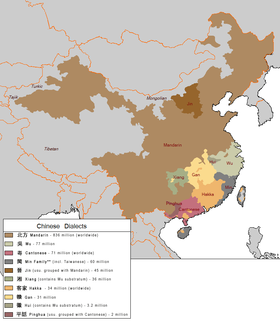ಚೀನಿ ಭಾಷೆ
| ಚೀನಿ ಭಾಷೆ 汉语/漢語 ಹಾನ್ಯೂ, 中文 ಜೋಂಗ್ವೇನ್ | ||
|---|---|---|
| ಬಳಕೆಯಲ್ಲಿರುವ ಪ್ರದೇಶಗಳು: |
ಚೀನ, ಮಲೇಶಿಯ, ಸಿಂಗಾಪುರ್, ಇತ್ಯಾದಿ | |
| ಪ್ರದೇಶ: | ಪೂರ್ವ ಏಷ್ಯಾ, ಆಗ್ನೇಯ ಏಷ್ಯಾ | |
| ಒಟ್ಟು ಮಾತನಾಡುವವರು: |
ಸು. ೧.೩ ಬಿಲಿಯನ್ | |
| ಶ್ರೇಯಾಂಕ: | ಎಲ್ಲಾ ಸೇರಿ: ೧
ಮ್ಯಾಂಡರಿನ್: ೧ | |
| ಭಾಷಾ ಕುಟುಂಬ: | Sino-Tibetan ಚೀನಿ ಭಾಷೆ | |
| ಬರವಣಿಗೆ: | ಚೀನಿ ಲಿಪಿ | |
| ಅಧಿಕೃತ ಸ್ಥಾನಮಾನ | ||
| ಅಧಿಕೃತ ಭಾಷೆ: | ಟೆಂಪ್ಲೇಟು:Country data the Republic of China ಚೀನಿ ಗಣರಾಜ್ಯ | |
| ನಿಯಂತ್ರಿಸುವ ಪ್ರಾಧಿಕಾರ: |
||
| ಭಾಷೆಯ ಸಂಕೇತಗಳು | ||
| ISO 639-1: | zh
| |
| ISO 639-2: | chi / zho (B)ಟೆಂಪ್ಲೇಟು:Infobox ಭಾಷೆ/terminological
| |
| ISO/FDIS 639-3: | — | |
| ಚಿತ್ರ:Map of sinitic languages full-en.svg, Map of sinitic languages-ca.svg | ||
| ಟಿಪ್ಪಣಿ: ಈ ಪುಟದಲ್ಲಿ IPA ಧ್ವನಿ ಸಂಕೇತಗಳು ಯುನಿಕೋಡ್ನಲ್ಲಿ ಇರಬಹುದು. | ||
ಚೀನಿ ಭಾಷೆ (汉语/漢語, ಹಾನ್ಯೂ; 中文, ಝೋಂಗ್ವೇನ್) ಮೂಲತಃ ಹಾನ್ ಚೀನಿ ಜನರ ಭಾಷೆ. ಸಹಸ್ರಾರು ವರ್ಷಗಳ ಬೆಳವಣಗೆಯಿಂದ ಇದು ಅನೇಕ ಸ್ವರೂಪಗಳನ್ನು ಹೊಂದಿ ಇಂದು ಒಂದು ಭಾಷಾ ಕುಟುಂಬವೆನ್ನಬಹುದಾದಷ್ಟು ವೈವಿಧ್ಯ ಭಾಷೆಗಳ ಸಂಕಲನವಾಗಿದೆ. ಚೀನಿ-ಟಿಬೆಟನ್ ಮುಖ್ಯ ಭಾಷಾ ಕುಟುಂಬಕ್ಕೆ ಇದು ಸೇರಿದೆ.[೧] About one-sixth of the world’s population, or over one billion people, speak some form of Chinese as their native language. The identification of the varieties of Chinese as "languages" or "dialects" is controversial.[೨] As a language family Chinese has an estimated nearly 1.2 billion speakers; Mandarin Chinese alone has around 851 million native speakers, outnumbering any other language in the world.[೩][೪]
Spoken Chinese is distinguished by its high level of internal diversity, though all spoken varieties of Chinese are tonal and analytic. There are between six and twelve main regional groups of Chinese (depending on classification scheme), of which the most populous (by far) is Mandarin (c. 850 million), followed by Wu (c. 90 million), Min (c. 70 million) and Cantonese (c. 70 million). Most of these groups are mutually unintelligible, though some, like Xiang and the Southwest Mandarin dialects, may share common terms and some degree of intelligibility. Chinese is classified as a macrolanguage with thirteen sub-languages in ISO 639-3, though the identification of the varieties of Chinese as multiple "languages" or as "dialects" of a single language is a contentious issue.
The standardized form of spoken Chinese is Standard Mandarin "普通话/普通話 (pinyin: pǔtōnghùa); 国语/國語 (pinyin: gúoyǔ)", based on the Beijing dialect. Standard Mandarin is the official language of the People's Republic of China, the Republic of China in Taiwan, as well as one of four official languages of Singapore. Chinese—de facto, Standard Mandarin—is one of the six official languages of the United Nations. Of the other varieties, Standard Cantonese is common and influential in Cantonese-speaking overseas communities, and remains one of the official languages of Hong Kong (together with English) and of Macau (together with Portuguese). Min Nan, part of the Min language group, is widely spoken in southern Fujian, in Taiwan (where it is known as Taiwanese or Hoklo) and in Southeast Asia (where it dominates in Singapore, Malaysia and the Philippines and is known as Hokkien).
Spoken Chinese
[ಬದಲಾಯಿಸಿ]
The map below depicts the linguistic subdivisions ("languages" or "dialect groups") within China itself. The traditionally-recognized seven main groups, in order of population size are:
- Guan (Mandarin) 北方話/北方话 or 官話/官话, (c. 885 million),
- Wu 吳/吴 , which includes Shanghainese, (c. 77 million),
- Yue (Cantonese) 粵/粤, (c. 71 million),
- Min 閩/闽, which includes Taiwanese, (c. 60 million),
- Xiang 湘, (c. 36 million),
- Hakka 客家 or 客, (c. 34 million),
- Gan 贛/赣, (c. 31 million)
ಉಲ್ಲೇಖಗಳು
[ಬದಲಾಯಿಸಿ]- ↑ *David Crystal, The Cambridge Encyclopedia of Language (Cambridge: Cambridge University Press, 1987) , p. 312. “The mutual unintelligibility of the varieties is the main ground for referring to them as separate languages.”
- Charles N. Li, Sandra A. Thompson. Mandarin Chinese: A Functional Reference Grammar (1989), p 2. “The Chinese language family is genetically classified as an independent branch of the Sino-Tibetan language family.”
- Jerry Norman. Chinese (1988), p.1. “The modern Chinese dialects are really more like a family of language.
- ↑ Mair, Victor H. (1991). "What Is a Chinese "Dialect/Topolect"? Reflections on Some Key Sino-English Linguistic Terms" (PDF). Sino-Platonic Papers.
- ↑ Ethnologue report for language code:cmn
- ↑ Ethnologue report for language code:eng
